
Graphium cloanthus, the glassy bluebottle, is a common, non-threatened tropical butterfly of the family Papilionidae.

Ixias pyrene, the yellow orange tip, is a small butterfly of the family Pieridae, that is, the yellows and whites, which is found in Sri Lanka, India and southeast Asia.

Symbrenthia lilaea, the peninsular jester, is a species of nymphalid butterfly found in South Asia and Southeast Asia. It forms a superspecies with Symbrenthia hippoclus. There are numerous regional forms, and the taxonomy of the group is not well resolved.
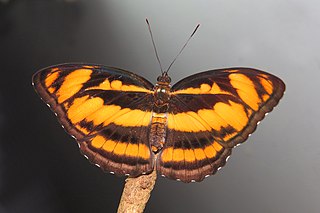
Athyma nefte, the colour sergeant, is a species of brush-footed butterfly found in tropical South and Southeast Asia.

Calinaga buddha, the freak, is a species of butterfly in the Calinaginae subfamily that is found in parts of Southeast Asia, China and in India.
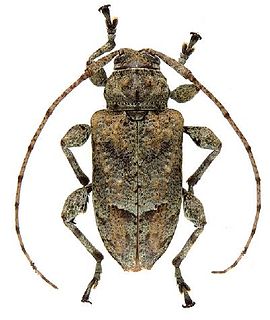
Leptostylopsis annulipes is a species of longhorn beetles of the subfamily Lamiinae.
Xyroptila peltastes is a moth of the family Pterophoridae. It is found in Australia.

Deuterocopus atrapex is a moth of the family Pterophoridae described by Thomas Bainbrigge Fletcher in 1909. It has been recorded from Sri Lanka, Assam, Selangor, the Tenasserim Hills, south-eastern Borneo, Ternate, Ambon Island, Batian, southern Sulawesi, the Sangihe Islands, Halmahera, Neu Pommern, northern New Guinea, the Kei Islands, the D'Entrecasteaux Islands and Queensland.
Phaeosaces lindsayae is a species of moth in the family Depressariidae. It is endemic to New Zealand. It is classified as "Data Deficient" by the Department of Conservation.

Megachile campanulae, known as the bellflower resin bee, is a species of bee in the family Megachilidae. Described in 1903, these solitary bees are native to eastern North America. Studies in 2013 placed them among the first insect species to use synthetic materials for making nests. They are considered mason bees, which is a common descriptor of bees in several families, including Megachilidae. Within the genus Megachile, frequently also referred to as leafcutter bees, M. campanulae is a member of the subgenus Chelostomoides, which do not construct nests from cut leaves, but rather from plant resins and other materials. Females lay eggs in nests constructed with individual cell compartments for each egg. Once hatched, the eggs progress through larval stages and subsequently will overwinter as pupae. The bees are susceptible to parasitism from several other bee species, which act as brood parasites. They are medium-sized bees and the female adults are typically larger than the males. They are important pollinators of numerous native plant species throughout their range.

Brachyopa flavescens , The Yellow Sapeater, is a fairly common, species of syrphid fly. It has been observed in Northeastern North America. Hoverflies get their names from the ability to remain nearly motionless while in flight The adults, also known as flower flies for they are commonly found around and on flowers from which they get both enegy-giving nectar and protein rich pollen. Larvae for this genus are of the rat-tailed type. B.flavescens larvae have not been described.

Brachyopa daeckei , the black-tailed sapeater , is a rare species of syrphid fly that has been observed in North Eastern North America. Hoverflies get their names from the ability to remain nearly motionless while in flight The adults are also known as flower flies for they are commonly found around and on flowers from which they get both enegy-giving nectar and protein rich pollen. Larvae for this genus are of the rat-tailed type. B.daeckei larvae have not been described.
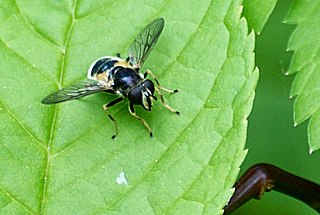
'Blera confusa , the confusing Wood Fly, is a common species of syrphid fly first officially described by Johnson, 1913 Hoverflies get their names from the ability to remain nearly motionless while in flight. The adults are also known as flower flies for they are commonly found around and on flowers, from which they get both energy-giving nectar and protein-rich pollen. The larvae are of the rat-tailed type feeding on exuding sap or in the rot holes of trees.
Blera analis, the Orange-tailed wood fly, is an uncommon species of syrphid fly first officially described by Macquart, 1842. Hoverflies get their names from the ability to remain nearly motionless while in flight. The adults are also known as flower flies for they are commonly found around and on flowers from which they get both energy-giving nectar and protein-rich pollen. The larvae are of the rat-tailed type feeding on exuding sap or in the rot holes of trees.
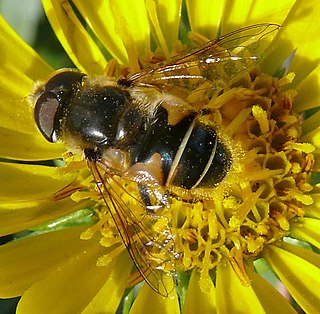
Eristalis hirta, the black-footed drone fly, is a common Western North American species of syrphid fly first officially described by Loew in 1866 Hoverflies get their names from the ability to remain nearly motionless while in flight The adults are also know as flower flies for they are commonly found around and on flowers from which they get both enegy-giving nectar and protein rich pollen. The larvae are aquatic filter-feeders of the rat-tailed type.
'Blera metcalfi , Metcalf's wood fly, is a rare species of syrphid fly first officially described by Curran in 1925 Hoverflies get their name from the ability to remain nearly motionless while in flight. The adults are also known as flower flies for they are commonly found around and on flowers from which they get both energy-giving nectar and protein rich pollen. The larvae are of the rat-tailed type feeding on exuding sap or in the rot holes of trees.

Brachyopa cynops , the Matt-tailed Sapeater, is a rare species of syrphid fly. It has been collected in Colorado. Hoverflies get their names from the ability to remain nearly motionless while in flight. The adults are also known as flower flies for they are commonly found around and on flowers from which they get both enegy-giving nectar and protein rich pollen. Larvae for this genus are of the rat-tailed type. B.cynops larvae have not been described.

Hierodoris stellata is a species of moth in the family Plutellidae. It is endemic to New Zealand and is found in Fiordland and Dunedin. This species has been found in coastal native forest. Larvae feed on Astelia flower-spikes and adults are on the wing in late December and January. It has been stated that this species belongs to the genus Charixena however this placement has yet to be published. As such this species is currently known as Hierodoris (s.l.) stellata or 'Hierodoris'stellata.
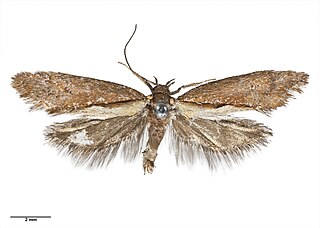
Tingena laudata is a species of moth in the family Oecophoridae. It is endemic to New Zealand and has been observed in Fiordland and Otago. Adults of this species are on the wing in January.

Sphiximorpha willistoni, or Williston's wasp fly, is a rare species of syrphid fly found in eastern North America. It is a strong wasp mimic. Hoverflies can remain nearly motionless in flight. The adults are also known as flower flies for they are commonly found on flowers from which they get both enegy-giving nectar and protein rich pollen. Larvae in this genus are found in sap runs of trees.















